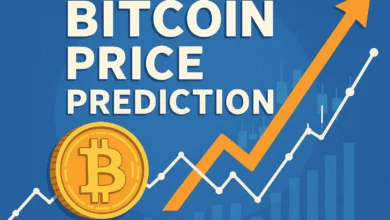
Driven by a significant reduction in global geopolitical tensions, the Bitcoin Market is seeing a notable comeback as Bitcoin approaches the $110,000 price level. This rise in Bitcoin’s value has flowed across the digital asset ecosystem and led to price hikes of up to 5% for various altcoins.
Knowing the mechanics behind these moves requires thoroughly investigating the interaction among macroeconomic elements, geopolitical events, investor attitude, and technical market indicators. This article explores the complex terrain influencing current crypto values, offering thorough insights best suited for amateurs and experts looking to understand the cryptocurrency market better.
Geopolitical Stability and Monetary Policy Fuel Bitcoin Surge
Often considered the flagship cryptocurrency, Bitcoin has long been shaped by more general geopolitical and economic events. Driven mainly by a decrease in geopolitical instability, its recent surge close to the $110,000 level signals a noteworthy event. Diplomatic progress toward major international flashpoints, including the United States, China, Russia, and European countries, has lately experienced diplomatic progress, hence lowering concerns of trade wars, military conflicts, and sanctions, which usually generate market volatility.

Historically, Bitcoin has attracted investors during times of instability as a “digital gold” hedge that offers a distributed alternative to conventional fiat currencies and government-owned assets. The geopolitical calm of today has calmed investors and opened the path for fresh risk appetite, stimulating more capital flow into cryptocurrencies. Moreover, this movement aligns with the indications of the U.S. Federal Reserve toward keeping a dovish monetary policy posture, so addressing issues of forceful interest rate increases and promoting risk asset appreciation.
Altcoin Market Rebound Driven by Ethereum 2.0
The rising momentum in Bitcoin has created a suitable habitat for altcoins, which have seen price rises of up to 5%. Across different markets, the continuous transition to Ethereum 2.0, the second-largest cryptocurrency by market capitalization, has shown considerable strength. Using a proof-of-stake consensus method and sharding, which significantly lowers transaction costs and energy consumption, this improvement seeks to overcome scaling problems. Such advancements inspire a positive attitude in the Ethereum ecosystem by boosting confidence among investors and devs equally.
Positive market attitude has also helped other altcoins, including Binance Coin (BNB), Cardano (ADA), and Solana (SOL). Supported by the large user base of the platform and creative product offers, Binance Coin—which is directly related with the Binance exchange and its distributed finance (DeFi) ecosystem—is While Solana’s excellent throughput and low latency make it a favorite choice for distributed apps and Web3 projects, Cardano’s focus on academic research and peer-reviewed development has drawn a robust community.
Geopolitical Stability Driving Bitcoin Market
In recent years, the link between geopolitical events and bitcoin values has grown relatively clear-cut. Unlike conventional markets, cryptocurrencies appeal to investors during geopolitical uncertainty or economic sanctions by providing distinctive financial sovereignty. Relaxing tensions in areas such as Eastern Europe and East Asia have thus sparked the present crypto surge.
For instance, the diplomatic thaw in U.S.-China relations has lessened worries about a tech cold war becoming more severe and addressed issues about blockchain innovation and bitcoin exchanges being limited. Likewise, peace calls in the Russia-Ukraine war and related sanctions danger have eliminated significant uncertainty from financial markets, allowing a more hopeful view.
Another key is regulatory clarity. Countries that support sensible cryptocurrency control—including Switzerland, Singapore, and the United Arab Emirates—are creating innovative hotspots that attract talent and money. On the other hand, areas with hostile legal policies sometimes witness capital flight into more favorable countries or distributed networks, which emphasizes the need for geopolitical stability for the state of the crypto market.
Investor Optimism and Technical Momentum Drive Crypto Markets
Beyond geopolitical triggers, market mood is still a significant force influencing bitcoin’s price movement. On-chain measures and social media analytics expose growing hope among institutional and ordinary investors. The popular emotion indicator,, the Fear & Greed Index,, has changed to show “greed,” which reflects increasing optimism and readiness to enter the market once more.
Technically, Bitcoin’s present price behavior approaching $110,000 fits important resistance and psychological thresholds. Though traders remain wary given the historically erratic character of crypto markets, indicators such as the Relative Strength Index (RSI) and Moving Average Convergence Divergence (MACD) show great positive momentum.
Altcoins show mixed technical indicators, depending mostly on their specific project updates and market orientation. While developing altcoins remains extremely sensitive to more general market fluctuations, Ethereum’s consolidation above key support levels suggests possible breakouts matched with the last phases of the Ethereum 2.0 upgrade.
Institutional Adoption Driving Bitcoin Market Maturity
The maturing phase of the Bitcoin market still revolves mainly around institutional engagement. Strong institutional conviction is shown by entities like MicroStrategy, under Michael Saylor, who have dramatically raised their Bitcoin holdings. Moreover, investment behemoths like BlackRock and Fidelity are extending their crypto products, facilitating the participation of pension and mutual funds.

The approval of Bitcoin futures ETFs in several countries, including Canada and possibly the United States, signals a turning point in market infrastructure, enabling higher liquidity and regulatory control. Improved compliance systems, custodial solutions, and strengthened security protocols, taken together, have helped build institutional confidence.
Cryptocurrency Outlook Amid Evolving Economic
Looking ahead, the course of Crypto market prices will remain entwined with changing macroeconomic conditions, technical innovation, and legislative changes. Although the present reduction of geopolitical tensions offers a good background, hazards such as fresh hostilities, government crackdowns, or inflationary pressures still exist.
Potential drivers of the next wave of altcoin appreciation are the continuous development of distributed finance (DeFi), non-fungible tokens (NFTs), and blockchain interoperability solutions. Cross-chain bridged layer two scaling solutions offer a solution to current network constraints, improving usability and adoption.
Final thoughts
Linking to related material like “Understanding Bitcoin’s Role in a Geopolitical Context” or “The Impact of Ethereum 2.0 on Crypto Market ” can give readers interested in broad knowledge, importance, and relevance. Reputable companies aim to improve credibility and dependability, as the World Economic Forum’s blockchain projects, the International Monetary Fund’s, and the International Financial Institutions ‘ fintech enhance credibility and reliability.








